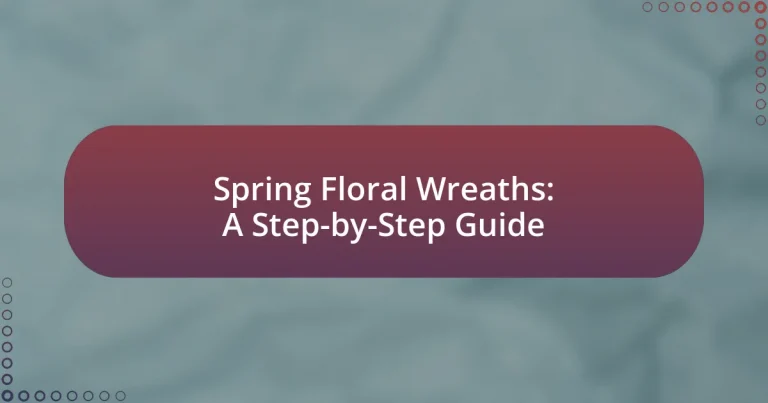Spring floral wreaths are decorative arrangements made from fresh or artificial flowers, symbolizing renewal and growth during the spring season. This article provides a comprehensive guide on creating spring floral wreaths, detailing the materials needed, techniques for assembly, and tips for personalization. It also explores the significance of seasonal elements, the best flowers to use, and creative display ideas for enhancing home decor. Additionally, the article addresses common mistakes to avoid and offers resources for further inspiration in floral design.

What are Spring Floral Wreaths?
Spring floral wreaths are decorative arrangements made primarily of fresh or artificial flowers, designed to celebrate the spring season. These wreaths typically feature vibrant colors and a variety of blooms, symbolizing renewal and growth associated with spring. They are often used as home decor, hung on doors or walls, and can also serve as centerpieces for seasonal celebrations. The use of spring floral wreaths dates back to ancient cultures, where they were crafted for various ceremonial purposes, reinforcing their significance in seasonal festivities.
How are Spring Floral Wreaths different from other wreaths?
Spring Floral Wreaths are distinct from other wreaths primarily due to their seasonal design, which incorporates fresh or artificial flowers that reflect the vibrant colors and themes of spring. Unlike traditional wreaths that may use evergreen foliage or dried materials, Spring Floral Wreaths emphasize blooming flowers, pastel colors, and elements like greenery that symbolize renewal and growth. This seasonal focus aligns with the characteristics of spring, making them particularly suitable for celebrations such as Easter or springtime gatherings.
What seasonal elements are typically included in Spring Floral Wreaths?
Spring floral wreaths typically include seasonal elements such as fresh flowers, greenery, and decorative accents. Common flowers used are tulips, daffodils, hyacinths, and cherry blossoms, which symbolize renewal and growth. Greenery like ferns and eucalyptus adds texture and a natural feel, while decorative accents may include ribbons, eggs, or butterflies, enhancing the spring theme. These elements collectively reflect the vibrant colors and fresh scents associated with the spring season, making the wreaths visually appealing and seasonally appropriate.
Why are Spring Floral Wreaths popular during the spring season?
Spring floral wreaths are popular during the spring season because they symbolize renewal and the vibrant colors associated with blooming flowers. This seasonal decoration reflects the natural beauty of spring, as many flowers such as tulips, daffodils, and cherry blossoms are in full bloom, making wreaths an appealing way to celebrate the season. Additionally, the use of fresh or artificial flowers in wreaths allows for a variety of designs that can enhance home decor, creating a welcoming atmosphere as people transition from winter to spring.
What materials are commonly used in Spring Floral Wreaths?
Common materials used in Spring Floral Wreaths include fresh flowers, greenery, floral wire, and a base such as a grapevine or foam wreath form. Fresh flowers like tulips, daffodils, and peonies are popular for their vibrant colors, while greenery such as ferns and eucalyptus adds texture. Floral wire is essential for securing the flowers and foliage, and the base provides structure and support for the arrangement. These materials are chosen for their seasonal availability and aesthetic appeal, making them ideal for creating vibrant and lively wreaths that celebrate spring.
What types of flowers are best for Spring Floral Wreaths?
The best types of flowers for Spring Floral Wreaths include tulips, daffodils, hyacinths, and cherry blossoms. These flowers are commonly associated with spring due to their vibrant colors and seasonal availability. Tulips and daffodils bloom early in the season, providing bright hues, while hyacinths add fragrance and texture. Cherry blossoms symbolize renewal and are visually striking, making them ideal for wreaths. Their popularity in spring floral arrangements is supported by their seasonal growth patterns and aesthetic appeal.
How do different materials affect the overall look of the wreath?
Different materials significantly influence the overall look of a wreath by altering its texture, color, and structural integrity. For instance, natural materials like twigs and dried flowers provide an organic, rustic appearance, while synthetic materials such as plastic or silk can create a more polished and vibrant look. Additionally, the choice of materials affects the wreath’s durability and seasonal adaptability; for example, a wreath made from weather-resistant materials can maintain its aesthetic appeal outdoors longer than one made from delicate, natural components. This versatility allows for a wide range of styles, from traditional to modern, depending on the materials selected.
How can you personalize a Spring Floral Wreath?
To personalize a Spring Floral Wreath, incorporate elements that reflect individual style and preferences, such as choosing specific flowers, colors, and decorative accents. For instance, selecting favorite blooms like tulips or daffodils can enhance personal significance, while adding unique items like ribbons, initials, or seasonal decorations can further tailor the wreath to one’s taste. Personalization not only makes the wreath visually appealing but also creates a meaningful connection to the creator’s identity or memories associated with springtime.
What techniques can be used to customize the design?
Techniques to customize the design of spring floral wreaths include selecting unique floral arrangements, varying the base materials, and incorporating personalized embellishments. Unique floral arrangements can be achieved by mixing different types of flowers, such as tulips, daffodils, and peonies, to create a vibrant color palette. Varying base materials, such as using grapevine, foam, or wire frames, allows for different textures and styles. Personalized embellishments, like ribbons, seasonal decorations, or even family heirlooms, can enhance the wreath’s individuality. These techniques enable crafters to create distinctive and meaningful designs that reflect personal style and seasonal themes.
How can color choices influence the wreath’s theme?
Color choices significantly influence a wreath’s theme by conveying specific emotions and seasonal associations. For instance, bright colors like yellow and pink evoke feelings of joy and freshness, aligning with the vibrant essence of spring. In contrast, muted tones such as pastels can create a softer, more romantic atmosphere, suitable for a delicate spring theme. Research indicates that color psychology plays a crucial role in how individuals perceive and react to visual stimuli, reinforcing the idea that color selection directly impacts the thematic expression of a wreath.

What are the steps to create a Spring Floral Wreath?
To create a Spring Floral Wreath, follow these steps: First, gather materials including a wreath base, floral wire, fresh or artificial flowers, greenery, and scissors. Next, secure the greenery to the wreath base using floral wire, ensuring it covers the base evenly. After that, arrange and attach the flowers to the greenery, using wire to secure them in place. Continue layering flowers and greenery until the desired fullness is achieved. Finally, trim any excess wire and hang the wreath using a ribbon or hook. This method ensures a balanced and visually appealing wreath, suitable for spring decoration.
What tools and supplies do you need to make a Spring Floral Wreath?
To make a Spring Floral Wreath, you need a wire wreath frame, floral wire, floral tape, a variety of fresh or artificial flowers, greenery, scissors, and a hot glue gun. The wire wreath frame serves as the base structure, while floral wire and tape are essential for securing the flowers and greenery in place. A selection of flowers and greenery provides the desired aesthetic, and scissors are necessary for cutting stems to the appropriate length. A hot glue gun can be used for additional securing of elements, ensuring durability and stability in the final arrangement.
How do you choose the right base for your wreath?
To choose the right base for your wreath, consider the materials and structure that best suit your design and intended use. Common bases include wire frames, foam rings, and grapevine, each offering different aesthetics and support for various floral arrangements. For example, wire frames provide a sturdy foundation for heavier flowers, while foam rings are ideal for fresh blooms that require water retention. Grapevine bases offer a rustic look and are excellent for dried or silk flowers. Selecting the appropriate base ensures your wreath maintains its shape and durability, enhancing the overall visual appeal.
What floral arrangement techniques should you know?
Key floral arrangement techniques to know include the spiral technique, the grid method, and the layering technique. The spiral technique involves arranging flowers in a circular pattern while holding them at an angle, creating a natural look. The grid method uses a grid of tape on the vase to position flowers precisely, ensuring stability and structure. The layering technique involves placing larger flowers at the base and smaller ones on top, adding depth and dimension to the arrangement. Mastering these techniques enhances the aesthetic appeal and longevity of floral designs, making them essential for effective floral arrangement.
How do you assemble a Spring Floral Wreath?
To assemble a Spring Floral Wreath, start by gathering a wire wreath frame, floral wire, and a variety of spring flowers and greenery. Secure the flowers and greenery to the frame using floral wire, layering them to create a full appearance. Continue adding flowers and foliage until the wreath is evenly covered, ensuring to vary the colors and textures for visual interest. This method is effective as it allows for customization and ensures durability, making the wreath suitable for display during the spring season.
What is the best order to add materials to the wreath?
The best order to add materials to the wreath is to start with the base, followed by larger focal elements, then medium-sized decorations, and finally, smaller accents. This method ensures a balanced and visually appealing arrangement. Starting with the base, such as greenery or a foam wreath form, provides a foundation. Adding larger focal elements, like flowers or large ornaments, creates visual interest. Next, incorporating medium-sized decorations fills in gaps, while smaller accents, such as berries or ribbons, add detail and texture. This structured approach is commonly used in floral design to achieve a cohesive look.
How can you ensure the flowers stay secure in the wreath?
To ensure the flowers stay secure in the wreath, use floral wire to attach each flower stem to the base. This method provides stability and prevents the flowers from shifting or falling out. Additionally, applying hot glue to the stems and the base can further reinforce their position, creating a more durable arrangement. Studies in floral design emphasize that using these techniques significantly enhances the longevity and stability of floral arrangements, ensuring they maintain their intended appearance over time.
What finishing touches can enhance your Spring Floral Wreath?
Adding a bow made of natural fibers, such as jute or burlap, can enhance your Spring Floral Wreath by providing a rustic touch. This finishing touch not only complements the floral elements but also adds texture and visual interest. Additionally, incorporating small decorative items like butterflies or ladybugs can create a whimsical feel, making the wreath more engaging. These elements are commonly used in floral arrangements to evoke the essence of spring, as they resonate with themes of renewal and nature.
How can ribbons and other embellishments be used effectively?
Ribbons and other embellishments can be used effectively in spring floral wreaths by enhancing visual appeal and adding texture. Incorporating ribbons in various widths and colors can create depth and contrast, while embellishments like beads or artificial flowers can provide focal points that draw the eye. For instance, using a wide, pastel-colored ribbon can evoke a spring theme, while smaller embellishments can fill gaps and add interest. Studies in design principles indicate that contrasting elements can increase aesthetic value, making the wreath more visually engaging.
What are some tips for preserving the freshness of the wreath?
To preserve the freshness of a wreath, keep it in a cool, shaded area away from direct sunlight and heat sources. This environment slows down the wilting process and maintains moisture levels. Additionally, misting the wreath with water every few days helps to hydrate the flowers and foliage, extending their lifespan. Using floral preservatives in the water can also enhance freshness by providing essential nutrients. Regularly checking for any wilted or dried elements and removing them promptly prevents decay from spreading to healthier parts of the wreath.

What are some creative ideas for displaying Spring Floral Wreaths?
Creative ideas for displaying Spring Floral Wreaths include hanging them on front doors, using them as centerpieces on dining tables, and showcasing them on walls as art pieces. Hanging wreaths on doors creates an inviting entrance, while placing them on tables adds a seasonal touch to dining experiences. Additionally, wall displays can transform a room’s aesthetic, making wreaths a versatile decorative element.
Where are the best places to hang a Spring Floral Wreath?
The best places to hang a Spring Floral Wreath include the front door, entryway walls, and above a fireplace mantel. Hanging a wreath on the front door creates an inviting entrance, while placing it in an entryway adds a touch of seasonal decor that greets guests. Additionally, positioning a wreath above a fireplace mantel serves as a focal point in the living room, enhancing the overall aesthetic of the space. These locations are ideal because they maximize visibility and impact, allowing the vibrant colors and floral designs to be appreciated fully.
How can you use Spring Floral Wreaths for special occasions?
Spring floral wreaths can be used for special occasions by serving as decorative accents for events such as weddings, birthdays, and seasonal celebrations. These wreaths enhance the ambiance with their vibrant colors and fresh floral scents, making them ideal for welcoming guests or as centerpieces. For instance, a spring floral wreath can be placed on doors to greet attendees or used as table decorations to complement the theme of the event. Additionally, they can be customized with specific flowers that hold significance for the occasion, such as roses for anniversaries or daisies for birthdays, thereby adding a personal touch.
What are some unique display ideas beyond the front door?
Unique display ideas beyond the front door include using window boxes filled with seasonal flowers, hanging planters on porch railings, and creating a garden-themed display on a side wall with vertical planters. These options enhance curb appeal and invite guests to explore the home’s exterior. For instance, window boxes can be customized with colorful blooms that reflect the season, while vertical planters can utilize space efficiently and add greenery to otherwise bare walls.
What are common mistakes to avoid when making Spring Floral Wreaths?
Common mistakes to avoid when making Spring Floral Wreaths include using inappropriate materials, neglecting proper wiring techniques, and failing to consider the overall balance and design. Using materials that are not suitable for outdoor conditions can lead to premature deterioration; for instance, fresh flowers may wilt quickly if not properly hydrated. Neglecting wiring techniques can result in a wreath that falls apart, as secure attachment is crucial for longevity. Additionally, failing to achieve balance in the arrangement can create an unappealing look, as uneven distribution of flowers and foliage can detract from the wreath’s aesthetic. These mistakes can significantly impact the quality and durability of the final product.
How can improper material choices affect the wreath’s durability?
Improper material choices can significantly reduce a wreath’s durability by making it susceptible to environmental factors such as moisture, UV exposure, and temperature fluctuations. For instance, using non-weather-resistant materials like untreated wood or certain fabrics can lead to rapid deterioration, including warping, fading, or mold growth. Research indicates that synthetic materials, such as UV-resistant plastics, can enhance longevity by withstanding outdoor conditions better than natural materials. Therefore, selecting appropriate, durable materials is crucial for maintaining the structural integrity and appearance of a wreath over time.
What are the pitfalls of overloading the wreath with decorations?
Overloading a wreath with decorations can lead to a cluttered appearance and diminish its aesthetic appeal. When a wreath is excessively adorned, the individual elements may compete for attention, resulting in a chaotic look rather than a harmonious design. Additionally, an overloaded wreath can become heavy and difficult to hang, potentially causing damage to the door or wall it is displayed on. Furthermore, too many decorations can obscure the base of the wreath, making it hard to appreciate the craftsmanship and materials used. This principle is supported by design theories that emphasize balance and proportion in visual compositions, which suggest that simplicity often enhances beauty and effectiveness in decorative arrangements.
What tips can help you create the perfect Spring Floral Wreath?
To create the perfect Spring Floral Wreath, select a variety of fresh, seasonal flowers and greenery that complement each other in color and texture. Using flowers like tulips, daffodils, and peonies, along with greenery such as ferns or eucalyptus, enhances the wreath’s visual appeal. Additionally, ensure to use a sturdy base, such as a grapevine or foam wreath form, to support the arrangement. Secure the flowers and foliage with floral wire or hot glue for durability. Research indicates that incorporating a mix of shapes and sizes in floral arrangements can create a more dynamic and engaging design, making the wreath visually striking.
How can you experiment with different styles and designs?
To experiment with different styles and designs of spring floral wreaths, one can utilize various materials, colors, and arrangements. For instance, incorporating diverse floral types such as tulips, daisies, and peonies can create distinct aesthetics, while varying the base materials like grapevine, foam, or wire can influence the overall look. Additionally, experimenting with color palettes—such as pastels for a soft look or vibrant hues for a bold statement—can significantly alter the design. Research indicates that visual diversity in floral arrangements can enhance aesthetic appeal, as supported by studies on color theory and design principles in floral art.
What resources are available for inspiration and guidance?
Resources available for inspiration and guidance on creating spring floral wreaths include online platforms, books, and workshops. Websites like Pinterest and Instagram offer a plethora of visual ideas and tutorials, showcasing various styles and techniques. Additionally, books such as “The Flower Workshop” by Ariella Chezar provide detailed instructions and design principles. Local craft stores often host workshops where participants can learn hands-on skills from experienced florists, further enhancing their wreath-making abilities. These resources collectively support individuals in developing their creativity and technical skills in floral design.





